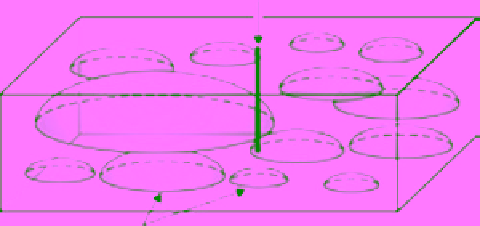Geoscience Reference
In-Depth Information
ACKNOWLEDGEMENTS
Definition of bed geometry
As an approximation of dune cross-set shape (Fig.
A-2A), the bed geometry is assumed to have a
roughly circular base and the maximum thickness
(
h
) in the central part (Fig. A-2B). The diameter of
the bed base, or bed breadth, is
w
=
ah
γ
, where
a
is
a constant and the exponent
γ
≥ 0 serves to scale the
bed breadth with its central thickness (Fig. A-3A).
If
γ
= 0, all beds have the same breadth
w
=
a
irre-
spective of their central thicknesses. If
γ
= 1, the
bed breadth scales linearly with the central thick-
ness (i.e. a bed that is twice as thick will also have
a lateral extent that is twice as great).
As argued by Malinverno (1997), the bed thick-
ness (
x
) away from the bed centre is only a function
of the lateral distance
r
and of the thickness
h
in the
central part (Fig. A-2B):
The paper stems from the first author's research
project sponsored by Statoil A.S.A. and con-
ducted through a post-doctoral fellowship at the
University of Bergen in 2006. The licence hold-
ers of the Kristin Field (Statoil, Petoro, Exxon
Mobil, Eni Norge and Total Norge) are thanked
for their permission to publish the data. We thank
also the Statoil's Kristin Field operation unit for
providing additional information and technical
support and Jamie Quin for discussions. The
manuscript was critically reviewed by Jonathan
Wonham, Gary Hampson and Snorre Olausen,
whose helpful comments are much appreciated
by the authors.
APPENDIX
γα
γ
xhrh rah
(
,
)
=−
[
12
(
/
) ]
for
0
≤≤
r
0 5
.
ah
(A1)
The tidal ridge bodies in the Garn Formation
consist of sandstone beds that are dune cross-sets,
stacked directly upon one another or separated by
beds of other sandstones facies. The cross-set beds
have a common origin and can be regarded as
small architectural elements of a sandstone ridge,
scattered in its 3D space. Let us consider that the
thicknesses of these beds are measured along a
vertical sampling line (Fig. A-1), such as an out-
crop or well-core log. The following review of
Malinverno's (1997) statistical theory explains
how the bed-volume frequency distribution can
be estimated from the frequency distribution of
the measured bed thicknesses.
where
α
> 0 is an exponent controlling the bulk
bed shape (Fig. A-3B). If 0 <
α
< 1, the bed thick-
ness decreases laterally most rapidly near the
centre. If
α
= 1, the thickness decreases uniformly
and the bed is broadly conical in shape. If
α
> 1,
there is little or no lateral thickness decrease near
the bed centre but rapid decrease at the margins,
such that the bed top is flat or slightly convex
upwards and the bed shape resembles an inverted
(A)
Sampling line (well)
(B)
h
x
r
ah
Y
2
Bed centre
Fig. A-2.
(A) Schematic geometry of a long-crested subaque-
ous dune that has migrated slightly in excess of twice its
wavelength (based on Allen, 1982). The height (thickness) of
dunes may range from ~ 7 cm to ≥ 20 m and scales with their
wavelength (Ashley, 1990). (B) A simplified 'inverted-
saucer' geometry assumed to represent a dune cross-set bed.
The bed has an approximately circular base, a maximum
thickness
h
in the central part and a thickness
x
at a distance
r
from the centre (modified from Malinverno, 1997, Fig. 5).
Sandstone beds
Fig. A-1.
Schematic illustration of the notion of the thick-
nesses of sandstone beds, such as dune cross-sets within a
tidal sandstone ridge, measured along a vertical sampling
line such as a well core. Diagram slightly modified from
Malinverno (1997, Fig. 4).



Search WWH ::

Custom Search